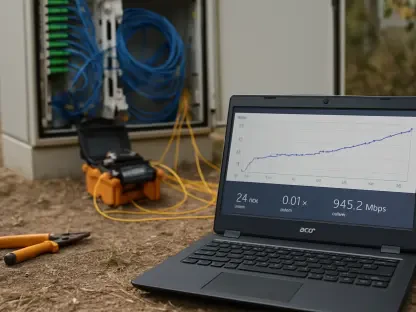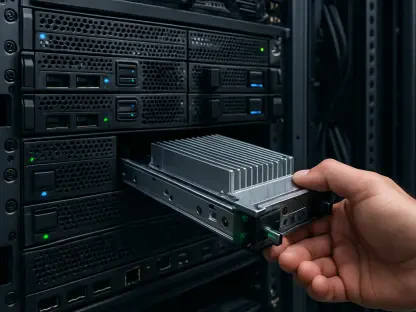In today’s rapidly advancing technological landscape, a paradigm shift is redefining the infrastructure of enterprises worldwide. As businesses seek innovative solutions to remain competitive, edge computing emerges as a transformative approach. This technological evolution is marked by the transition from centralized data processing systems to more distributed, real-time computing at the network’s edge. Edge computing involves processing data closer to its source—the sensors, machines, and devices that generate it—rather than sending it to centralized data centers. This proximity to data generation allows businesses to achieve faster insights and improved operational efficiencies across various sectors. With industries increasingly relying on immediate data processing and analysis, edge computing stands out as a strategic imperative, reshaping the ways industries operate and innovate in domains like healthcare, manufacturing, and retail.
The Convergence of Technologies in Edge Dynamics
The rise of edge computing as a revolutionary force is closely intertwined with several converging technological trends. As organizations strive to deploy intelligent systems at the edge, they benefit from advancements in hardware acceleration, platform engineering, and ecosystem integration. This fusion of technologies signifies more than a technical evolution; it represents a strategic shift in enterprise operations. Organizations now harness the capabilities of edge computing to drive significant operational impacts through scalable, flexible solutions. Analysts like John Furrier and Dave Vellante have highlighted this convergence by discussing the strategic focus of tech giants such as Dell Technologies on embedding edge computing into their core operations. This acceleration is particularly crucial as enterprises contend with an increasing volume of data, demanding prompt processing near its origins.
The resonance of edge computing in enterprise infrastructure is evidenced by Dell Technologies’ strategic initiatives. Michael Dell underscored the critical need for data to be processed in real-time within proximity to its source. For industries like healthcare or manufacturing, which rely on real-time analysis to maintain seamless operations, the conventional approach of directing data to centralized data centers proves inadequate. Enterprises increasingly find value in processing substantial portions of their data at the edge, where it is generated. The momentum is driven by the recognition that 75% of enterprise data demands real-time processing close to its origin, culminating in more decentralized data processing architectures. This trend highlights a broader industry movement steered by the need for efficiency and immediacy in data handling solutions.
Democratizing AI Through Edge Computing
A significant insight into the advancement of edge computing is its potential to democratize artificial intelligence (AI) for enterprises of all sizes. The facilitation of AI capabilities through edge computing signifies an opportunity for industries to leverage AI without depending solely on large-scale cloud resources. The concept of “AI factories” emerges, referring to orchestrated platforms that amalgamate storage, networking, and computing tasks into a cohesive operational structure tailored for diverse enterprise needs. This architecture caters to the demand for heterogeneous systems by accommodating components from industry leaders like Nvidia and AMD. It encourages more open ecosystems, allowing businesses to utilize a blend of technologies, thus expanding the appeal and accessibility of AI-driven solutions in edge environments.
Edge computing not only enables the democratization of AI but also represents a competitive edge for enterprises in unlocking new productivity potentials. The arrangement allows firms to harness AI with agility, resulting in innovations that may surpass traditional software industry growth rates. The collaboration between AI and edge computing presents prospects for redefined efficiency and value extraction from data. In this context, the industry witnesses a transformation where data utilization and AI integration illuminate new paths for productivity and functionality improvements. The implications extend beyond mere technicalities, embracing a broader scope where edge computing and AI together shape futuristic enterprise operations with speed and precision.
Modernizing Infrastructure While Enhancing Adoption
The journey towards integrating edge computing into enterprise systems entails modernizing existing infrastructures while promoting rapid adoption of edge solutions. This dual mandate proves challenging, demanding a balance between updating entrenched systems and fostering the newer, agile edge computing frameworks. Organizations like Dell Technologies face the task of rejuvenating their substantial base installations by upgrading components such as GPU racks and implementing cutting-edge thermal innovations. The refinement of reference architectures forms the cornerstone for building a foundation ready for hyperscale-level performance. Delivering these enhancements efficiently and cost-effectively remains critical to sustain competitiveness in an environment predicated on brisk technological evolution.
Time emerges as a crucial factor in successfully navigating this dual mandate. Corporations must swiftly adapt to provide high-performance and economical edge solutions to stay ahead of the competition. As edge computing establishes its foothold in the technological landscape, its adoption aligns with a broader strategic perspective prioritizing real-time data processing. With edge technologies gaining traction, businesses increasingly recognize the importance of transitioning from traditional infrastructures towards those that facilitate rapid innovation and responsiveness. The trajectory forward revolves around ensuring that enterprises not only embrace edge computing but also integrate it seamlessly within their existing operations to optimize strategic benefits and maintain a competitive edge.
A Forward-Looking Strategy for Edge Integration
The ascent of edge computing as a groundbreaking influence is deeply rooted in the convergence of several technological trends. Organizations aiming to implement smart systems at the edge harness advancements in hardware acceleration, platform engineering, and ecosystem integration, marking more than just a technical evolution but also a strategic transformation in business operations. By leveraging edge computing, companies achieve impactful operational improvements with scalable, adaptable solutions. Analysts such as John Furrier and Dave Vellante have observed this convergence, noting tech giants like Dell Technologies’ strategic emphasis on incorporating edge computing into core operations. This pace is vital as businesses face a growing amount of data demanding immediate processing close to its source.
Dell Technologies’ strategic plans highlight edge computing’s significance in enterprise infrastructure. Michael Dell emphasized the necessity of real-time data processing near its source, crucial for sectors like healthcare and manufacturing that depend on immediate analysis. Traditional data center processing is inadequate; thus, businesses increasingly value processing significant data at the edge. As 75% of enterprise data requires real-time processing, this trend leads to more decentralized data architectures, driven by the need for efficiency and speed.









